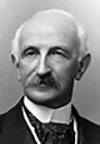
By: Jason K. Everett, Staff Writer, International
Judicial Monitor
Tobias Asser, born in Amsterdam on April 28, 1838, is best
known for his work in the formation of the Permanent Court of Arbitration
during the 1899 Hague peace conference which ultimately earned him, alongside
his colleague Albert Fried, a Nobel Prize.
Born into a family with a lineage in law, Tobias Asser began
his legal career studying at the Athanaeum in Amsterdam, earning a doctor’s
degree in law in 1860 at the age of 22. Asser practiced law for a brief period
but found greater focus in academe, scholarship, and politics. In 1862, he
accepted a posting at his alma mater to teach private law. He continued as a
professor of international and commercial law through Athanaeum’s transition to
the University of Amsterdam.
Asser co-founded the Revue de droit international et de
legislation comparee, a major journal of international law, first published
in 1869. Four years later he would be invited to participate in a conference
in Ghent the principal result of which was the formation of the Institute of International
Law, an organization that Asser would later lead.

 International
Judicial Monitor
International
Judicial Monitor